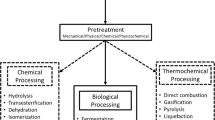Abstract
Fruit peels are a rich source of cellulose, hemicellulose, phenolic compounds, and terpenic compounds. Thus, they have the potential to be a novel renewable, sustainable, and low-cost raw material (source) for the production of several value-added products based on framework and concepts such as waste hierarchy that includes biofertilizers, dietary fiber, animal feed, industrial enzymes, substrate for the bioactive compounds production, synthesis of nanomaterials, and clean energy (from residual biomass). With a view of evaluating the environmental burden of biorefinery, a life cycle assessment (LCA) is performed for a representative citrus waste (CW) biorefinery. The functional unit used for LCA was set as 2500 kg of CW processed. The overall GWP was observed to be 937.3 kg CO2 equivalent per 2500 kg of CW processed. On further analysis of the environmental impact, it was found that different steps contributed significantly, as shown by the various environmental indicator values. Alternative advanced process intensification technologies like microwave and ultrasound-assisted steps replacing the conventional steps when implemented show considerable reduction in environmental indicator values. The variations in the contribution to environmental indicators should be considered during the design and process selection of biorefineries.





Similar content being viewed by others
References
Banerjee J, Singh R, Vijayaraghavan R, MacFarlane D, Patti AF, Arora A (2018) A hydrocolloid based biorefinery approach to the valorisation of mango peel waste. Food Hydrocoll 77:142–151
Barrera I, Amezcua-Allieri MA, Estupinan L, Martínez T, Aburto J (2016) Technical and economical evaluation of bioethanol production from lignocellulosic residues in Mexico: case of sugarcane and blue agave bagasses. Chem Eng Res Des 107:91–101. https://doi.org/10.1016/j.cherd.2015.10.015
Bernesson S, Nilsson D, Hansson PA (2006) A limited LCA comparing large-and small-scale production of ethanol for heavy engines under Swedish conditions. Biomass Bioenergy 30(1):46-57
Boukroufa M, Boutekedjiret C, Petigny L, Rakotomanomana N, Chemat F (2015) Bio-refinery of orange peels waste: a new concept based on integrated green and solvent free extraction processes using ultrasound and microwave techniques to obtain essential oil, polyphenols and pectin. Ultrason Sonochem 24:72–79. https://doi.org/10.1016/j.ultsonch.2014.11.015
Bousbia N, Vian MA, Ferhat MA, Meklati BY, Chemat F (2009) A new process for extraction of essential oil from Citrus peels: microwave hydrodiffusion and gravity. J Food Eng 90:409–413
Cherubini F, Jungmeier G (2010) LCA of a biorefinery concept producing bioethanol, bioenergy, and chemicals from switchgrass. Int J Life Cycle Assess 15(1):53–66
García MÁA, Vargas JHL, Molina DAR (2015) Agro-industrial fruit co-products in Colombia, their sources and potential uses in processed food industries: a review. Revista Facultad Nacional de Agronomía, Medellín 68(2):7729–7742
Giwa A, Adeyemi I, Dindi A, Lopez CG-B, Lopresto CG, Curcio S, Chakraborty S (2018) Techno-economic assessment of the sustainability of an integrated biorefinery from microalgae and Jatropha: a review and case study. Renew Sust Energ Rev 88:239–257 https://doi.org/10.1016/j.rser.2018.02.032
Gnansounou E, Pandey A (2016) Life-cycle assessment of biorefineries. Elsevier
ISO, EN 14040: 2006 Environmental management-Life cycle assessment-Principles and framework. European Committee for Standardization
López JÁS, Li Q, Thompson IP (2010) Biorefinery of waste orange peel. Crit Rev Biotechnol 30(1):63–69
Martínez-Ruano JA, Caballero-Galván AS, Restrepo-Serna DL, Cardona CA (2018) Techno-economic and environmental assessment of biogas production from banana peel (Musa paradisiaca) in a biorefinery concept. Environ Sci Pollut Res. https://doi.org/10.1007/s11356-018-1848-y
Mohan SV, Modestra JA, Amulya K, Butti SK, Velvizhi G (n.d.) A circular bioeconomy with biobased products from CO2 sequestration. Trends Biotechnol Article in Press. https://doi.org/10.1016/j.tibtech.2016.02.012
Papargyropoulou E, Lozano R, Steinberger J, Wright N, Ujang Z b (2014) The food waste hierarchy as a framework for the management of food surplus and food waste. J Clean Prod 76:106–115. https://doi.org/10.1016/j.jclepro.2014.04.020
Pathak PD, Mandavgane SA, Kulkarni BD (2015) Fruit peel waste as a novel low-cost bio adsorbent. Rev Chem Eng 31(4):361–381
Pathak PD, Mandavgane SA, Kulkarni BD (2016a) Characterizing fruit and vegetable peels as bioadsorbents. Curr Sci 110(11):2114–2123
Pathak PD, Mandavgane SA, Kulkarni BD (2016b) Valorization of banana peel: a biorefinery approach. Rev Chem Eng 30(6):651–666. https://doi.org/10.1515/revce-2015-0063
Pathak PD, Mandavgane SA, Kulkarni BD (2017a) Fruit peel waste: characterization and its potential uses. Curr Sci 113(3):444–454
Pathak PD, Mandavgane SA, Kulkarni BD (2017b) Valorization of pomegranate peel: a biorefinery approach. Waste Biomass Valoriz 8(4):1127–1137. https://doi.org/10.1515/revce-2015-0063
Pathak PD, Mandavgane SA, Kulkarni BD (2018) Waste to wealth: a case study of papaya peel. Waste Biomass Valoriz 1–12
Pourbafrani M, Forgács G, Horváth IS, Niklasson C, Taherzadeh MJ (2010) Production of biofuels, limonene and pectin from citrus wastes. Bioresour Technol 101(11):4246–4250. https://doi.org/10.1016/j.biortech.2010.01.077
Puligundla P, Obulam VSR, Oh SE, Mok C (2014) Biotechnological potentialities and valorization of mango peel waste: a review. Sains Malaysiana 43(12):1901–1906
Ravindran R, Jaiswal AK (2016) Exploitation of food industry waste for high-value products. Trends Biotechnol 34 1:58–69
Reay D (2008) The role of process intensification in cutting greenhouse gas emissions. Appl Therm Eng 28(16):2011–2019. https://doi.org/10.1016/j.applthermaleng.2008.01.004
Uihlein A, Schebek L (2009) Environmental impacts of a lignocellulose feedstock biorefinery system: an assessment. Biomass Bioenergy 33(5):793–802
Upadhyay A, Lama JP, Tawata S (2010) Utilization of pineapple waste: a review. Journal of Food Science and Technology Nepal 6:10–18
Wadhwa M, Bakshi MPS (2013) Utilization of fruit and vegetable wastes as livestock feed and as substrates for generation of other value-added products. Rap Publication 4:30
Wan YK, Sadhukhan J, Ng KS, Ng DKS (2016) Techno-economic evaluations for feasibility of sago-based biorefinery, part 1: alternative energy systems. Chem Eng Res Des 107:263–279. https://doi.org/10.1016/j.cherd.2015.11.001
Funding
The authors are thankful to the Department of Science and Technology, India, for providing research grant (grant no. DST/TDT/TDP-02/2017) to undertake the work. BDK acknowledges the support as SERB Distinguished Fellow.
Author information
Authors and Affiliations
Corresponding author
Additional information
Responsible editor: Philippe Loubet
Publisher’s note
Springer Nature remains neutral with regard to jurisdictional claims in published maps and institutional affiliations.
Rights and permissions
About this article
Cite this article
Joglekar, S.N., Pathak, P.D., Mandavgane, S.A. et al. Process of fruit peel waste biorefinery: a case study of citrus waste biorefinery, its environmental impacts and recommendations. Environ Sci Pollut Res 26, 34713–34722 (2019). https://doi.org/10.1007/s11356-019-04196-0
Received:
Accepted:
Published:
Issue Date:
DOI: https://doi.org/10.1007/s11356-019-04196-0




